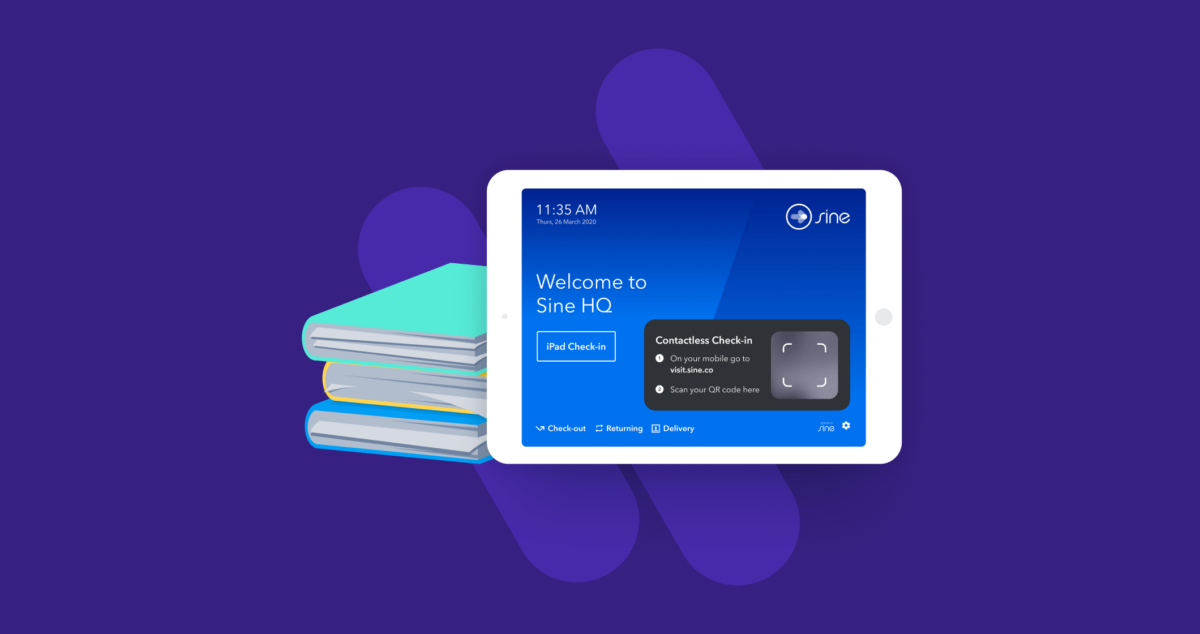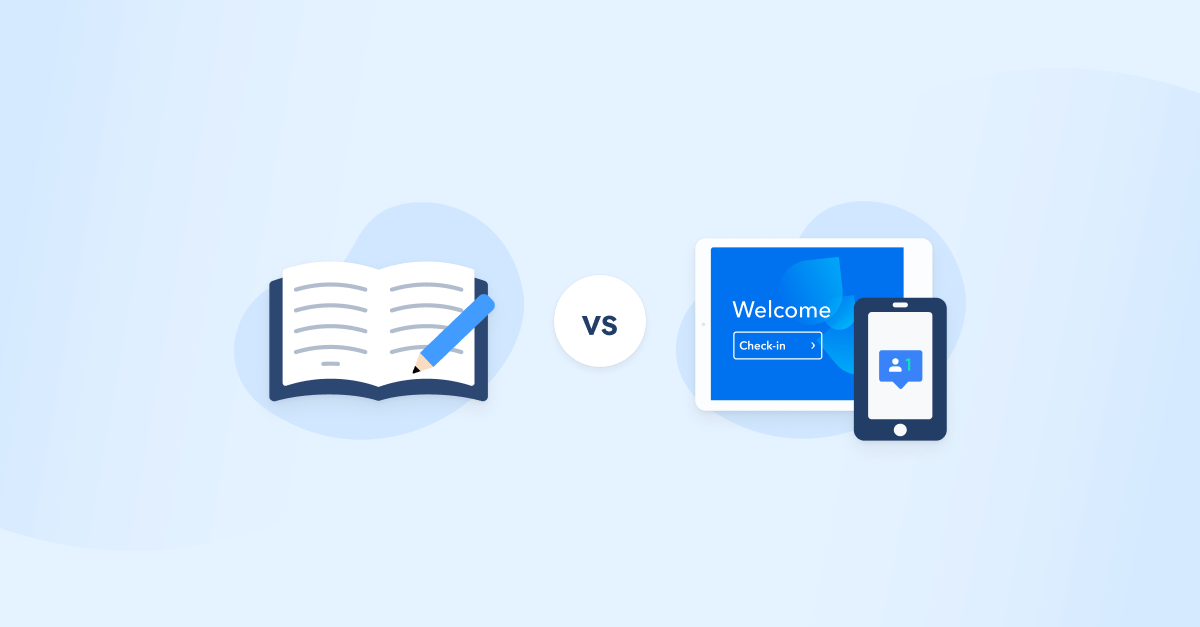
Remember the fax machine? When was the last time you received a fax? Well, we at Sine think the paper visitor book has headed the way of the fax machine.
Long gone…
Think about it, the first thing visitors, customers, and suppliers see when they visit your home base, HQ, and place of business is a tired and old-fashioned paper visitors’ book. Think about all the IT-related equipment you own and operate, yet the first impressions at your office in many cases involve this outdated, non-secure, and tatty process.
Digital visitor books are the way of the future!
Put simply, a digital visitor book is a digitized version of the traditional paper-based visitor book. Instead of visitors, contractors, and staff having to manually write their details into a physical book, a digital visitor book streamlines this through the ability to check in to a site via an iPad kiosk or mobile phone (and has the power to offer various other features that you may never have with a paper visitor book).
A visitor book is imperative to any organization that experiences visitations from those outside the company, as it records data such as their name, company name, contact information, the reason for visit, who they are there to see, and other key information. These records may be helpful for administration and managerial staff as they create a data set of the different types of visitors entering their site and provide an overview of how many visitors they average per day. Not only can this information be helpful for tracking purposes, but it may serve as a useful medium for identifying potential security weaknesses within the company (by demonstrating to key managerial stakeholders whether visitors are being compliant with organizational policies).
Visitor books can also be imperative during emergency drills or live evacuations, as they can provide admin staff with a list of everyone on site and their contact details.
With this in mind, here are 5 reasons to upgrade your paper visitor book to a modern, digital visitor management system.

Paper visitor books are still used today by organizations across the globe. Why? It’s been a standard visitor management method historically amongst workplaces, and change can be viewed as hard. So, the process of digitizing these traditional practices may be seen as daunting for some. However, this may not the case.
With the help of user-friendly software, the change to a digital visitor book can be simple. And when we consider the potential risks of data breaches that paper visitor books entail, transitioning to a digital solution may not only be less daunting after all but also the wiser choice for your business. Consider this, a paper visitor sign-in book shows details from all previous guests, which may include their name, company name, contact details, and maybe even why they are on site.
Having this personal information written down on a communal sign-in book may mean this data is on display for anyone to view. which could easily result in a potential data breach.
As we are entering into an increasingly digitized world, implementing electronic sign in systems like Sine, not only allows your guests to sign in digitally, but can also help take your workplace to the next level of modernization and assist with protecting the confidentiality of your visitor’s information. By using various methods of checking into a Site, such as contactless check-in using the SinePoint Pro app, utilizing the Fast Track QR feature to pre-fill the details of your visitors when they simply scan a QR code or just having guests sign in on an iPad kiosk when arriving on site, you can help ensure your visitor data is only accessible to approved, compliant personnel.

First impressions count. Not only may paper visitor books potentially expose your previous visitor’s data, but they can diminish your VIP guests’ first impressions when they are greeted with an old-fashioned, bland visitor book – instead of a modern user interface. Digital visitor books can help improve your front desk or site office’s image by combining a professional check-in experience with your company branding on a friendly, modern, and easy-to-use interface. Likewise, electronic visitor books may help make visitor registration an effortless and a delightful experience rather than a bore.
Digital visitor books may help your business project clearly to customers and special guests that you are a welcoming and innovative company. This can be done through elements such as displaying company logos, website graphics, and welcome messages on your iPad to match your corporate branding. Not only this, but digital visitor books include an array of features that can help make your visitors feel right at home, as well as streamlining previously manual visitor greeting processes. For instance, alerting your staff or “Hosts” via email, SMS and push notification when their visitor arrives, so your guests are not left waiting around.
Traditional paper visitor books can be costly – think of all the paper archiving and storage costs you may accumulate with paper-based registration systems. It all adds up. In fact, a 2022 survey conducted by Epson of IT decision-makers across 30 countries, found that 89% of these decision makers saw an increase in print costs over the previous 12-18 months. Not only that, according to IDC, a 2012 survey of information workers revealed that 2.8 hours are spent every week dealing with problems and time-consuming tasks that arise with paper documents.

So, not only can digital visitor books help companies save on ever-increasing printing costs, but they may help ease time-consuming burdens on employees. For instance, having to search for that missing printed document or going through pages of a visitor book to see who was on site and when.
As we truly start to witness the benefits of digitizing your visitor book for your guests and the company, it is also important to recognize the benefits that may be experienced by your staff. Manual, paper-based visitor management processes such as manually signing people in, contacting (or even having to search for) who the visitor is there to see, monitoring guest logs, or even having to verify if a visitor is still on site, may be extremely time-consuming and leave room for human error. By digitizing the sign in process, it can help enable seamless visitor flows alongside empowering your relevant employees to focus on creating a welcoming experience.

Ensuring and adhering to compliance protocols is without a doubt a high priority for organizations across the globe. A significant element of this is ensuring everyone entering your site, including visitors and contractors, are familiar with and follow your workplace (and industry) compliance policies. This may prove difficult with paper visitor books, as you cannot collect induction documents, review permits, or accept or reject visitors and contractors on a case-by-case basis if they are listed as a non-compliant visitor.
However, digital visitor management systems like Sine can help take compliance to the next level with Sine Workflows, allowing companies to digitize their induction processes (among other workflows) and can help ensure contractors have the required documentation and credentials to carry out work on site.
Let’s chat about your needs and how we can help.
Request demo